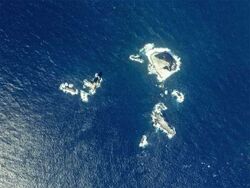Ōnohara Islands
Native name: 大野原島 | |
|---|---|
| File:Ohnoharajima01.jpg | |
| File:Map of Izu Islands.png | |
| Geography | |
| Location | Izu Islands |
| Coordinates | 34°02′41″N 139°23′15″E / 34.04472°N 139.38750°E |
| Archipelago | Izu Islands |
| Area | 0.2 km2 (0.077 sq mi) |
| Highest elevation | 114 m (374 ft) |
| Administration | |
Japan | |
| Prefecture | Tokyo |
| Subprefecture | Miyake Subprefecture |
| Village | Miyake |
| Demographics | |
| Population | 0 |
The Ōnohara Islands (大野原島, Ōnohara-jima) are a group of volcanic deserted islands located in the Philippine Sea approximately 180 kilometres (110 mi) south of Tokyo and 10 kilometres (6.2 mi) west of Miyake-jima, in the northern portion of the Izu archipelago, Japan. The group is also known as Sanbon-dake (三本岳, lit. “Three Peaks”) from its profile.
Geography
Ōnohara-jima consists of nine main islets and several smaller rocks and stacks. The island is the remnant of an andesite lava dome with sheer sides, the only visible portion of a submarine volcanic caldera. The above sea-level portion has a surface area of approximately 0.2 square kilometers, with a summit height of 114 metres (374 ft) on the main islet of Koyasu-shima (小安島). Located in the Kuroshio Current, the area has abundant sea life, and is popular with sports fishermen and scuba divers. During the Korean War, aircraft of the US Air Force used Ōnohara-jima as a bombing range, endangering the Japanese murrelet, a rare seabird that breeds on Ōnohara-jima. The bombing was stopped after Jack Moyer wrote a letter to an associate of then-US President Harry S. Truman.[1][2][3]


See also
References
- ↑ Gonzales, Mithi Laya S & Shinoke, Hidenori Co-Existing in Harmony with Nature: Local Conservation Groups at Miyake Island IBA, Tokyo, Japan Retrieved September 11, 2017
- ↑ Polunin, Nicholas World Who Is Who and Does What in Environment and Conservation page 224 Retrieved September 11, 2017
- ↑ Stephen Hesse. "'Miyake man' leaves a legacy of inspiration". The Japan Times. Retrieved 11 September 2017.
External links
- Quaternary Volcanoes in Japan
- Entry at Oceandots.com at the Wayback Machine (archived December 23, 2010)
- "Onoharajima". Global Volcanism Program. Smithsonian Institution. Retrieved 2021-06-25.